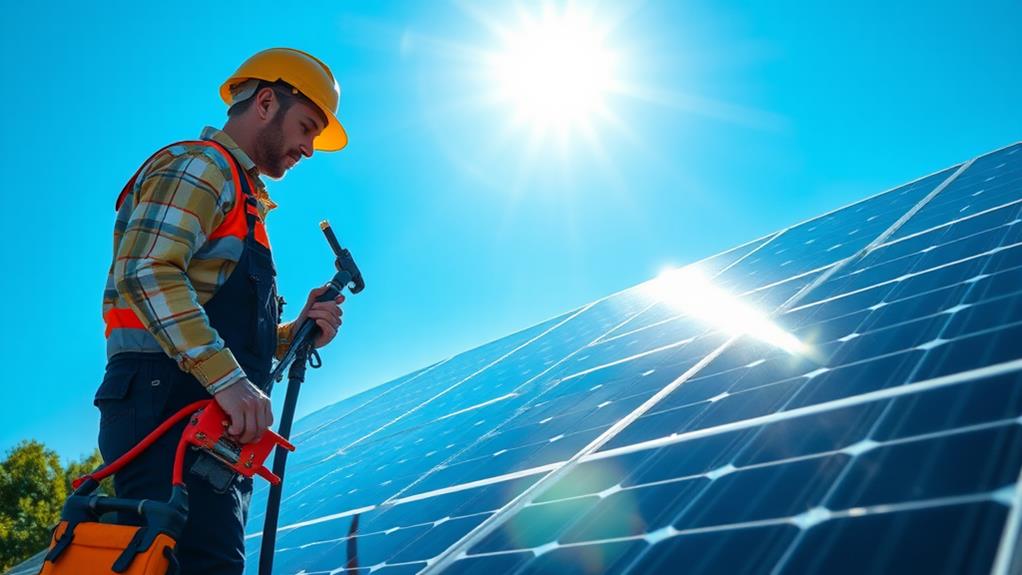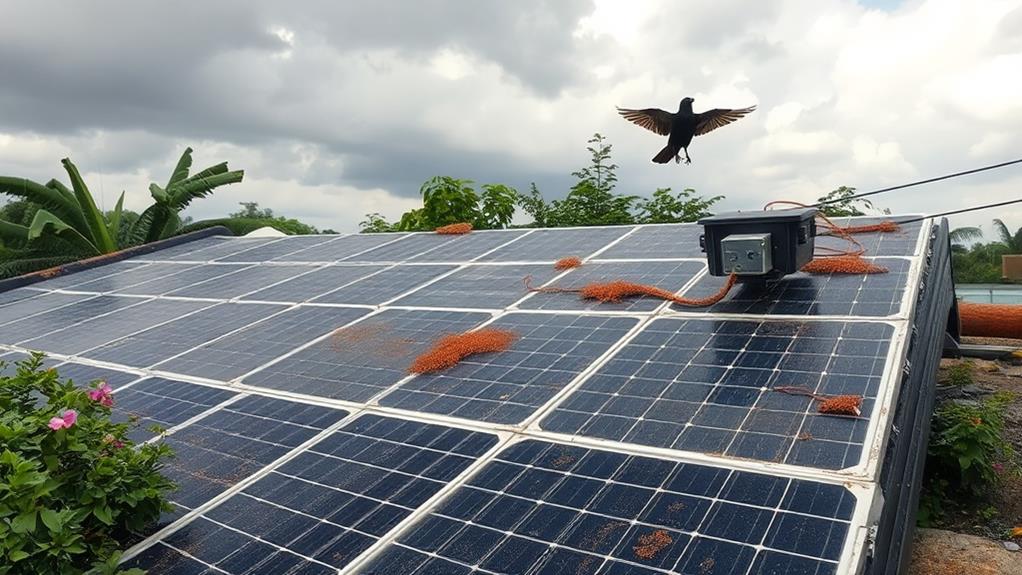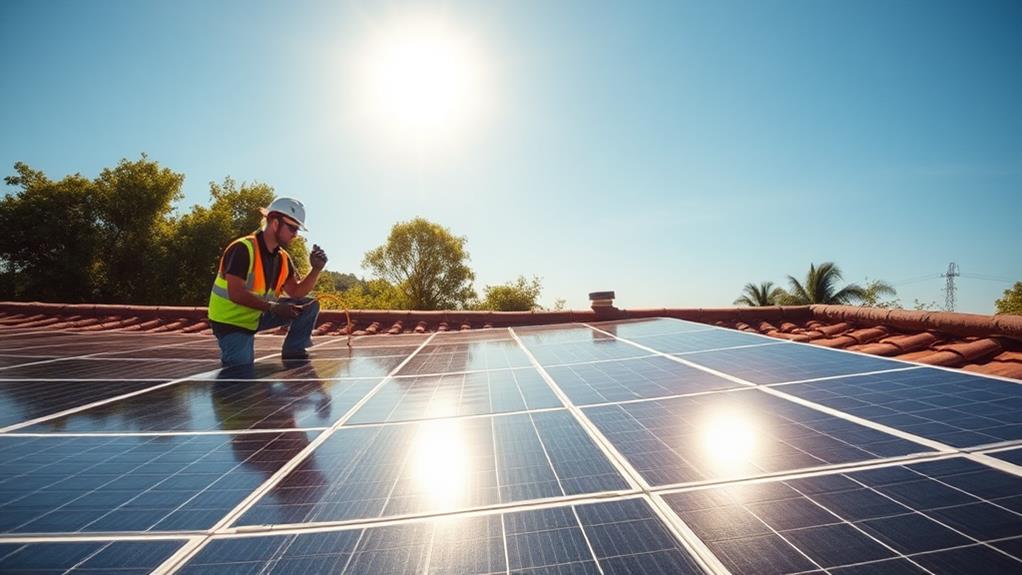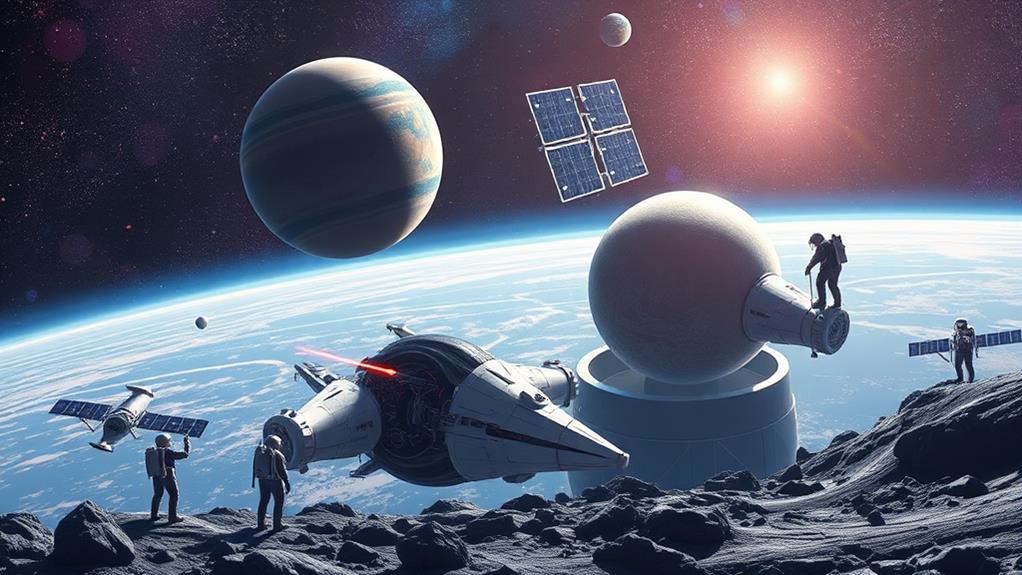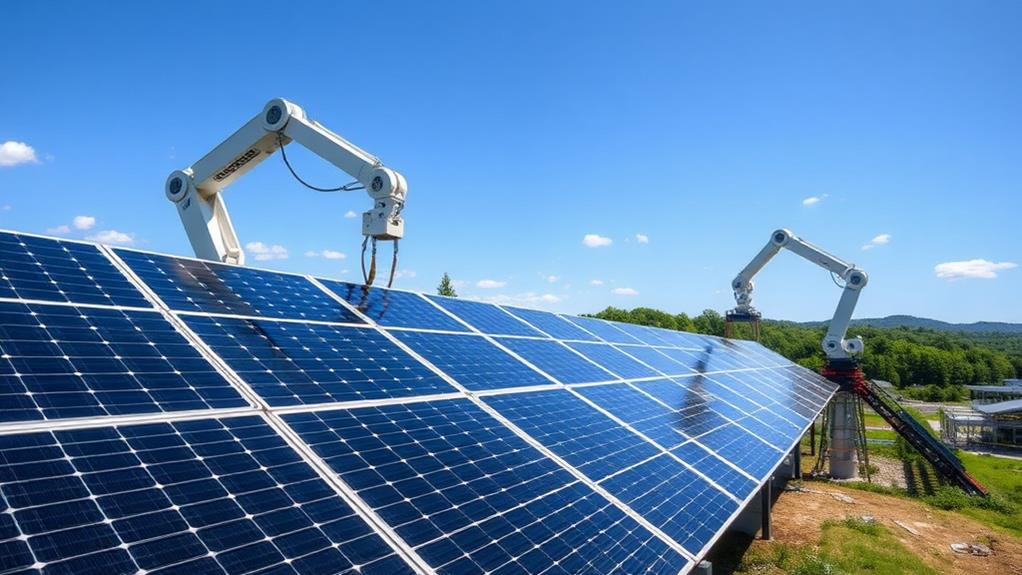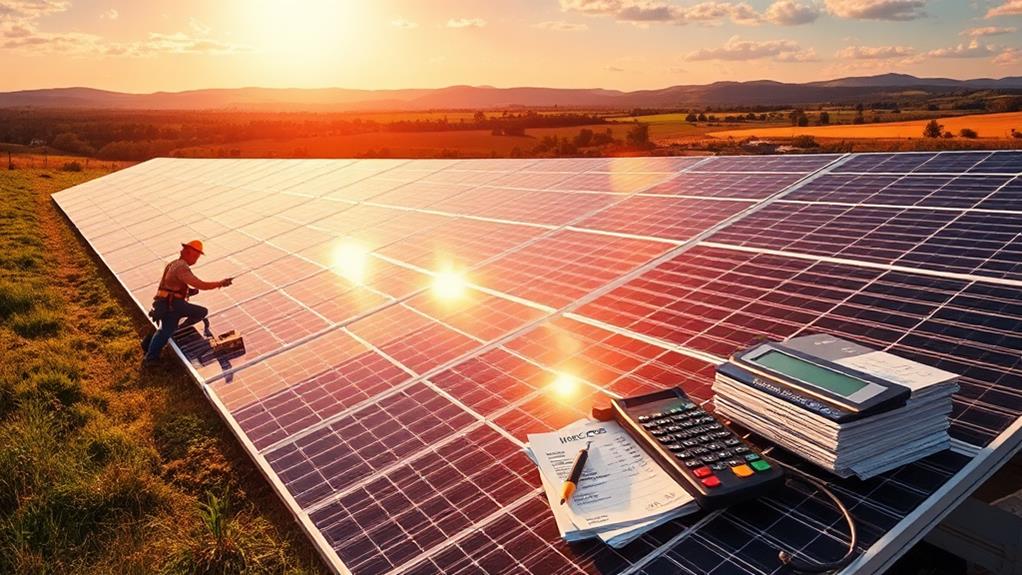When we consider the cost of solar mounting systems, we must look at material expenses, labor charges, and regional variations. Materials like high-quality aluminum systems impact durability but also raise initial costs. Skilled labor is vital, with installation complexity and regional differences affecting prices. Systems require key components such as cabling, and if we're including battery storage like the Tesla Powerwall, costs can vary significantly. Regional incentives and rebates can reduce financial burdens, but upfront investments differ between urban and rural areas. By grasping these factors, we can make informed decisions about solar system investments. Let's delve deeper into insights together.
Key Takeaways
- Solar panel costs vary significantly, impacting overall system expenses.
- Mounting equipment costs differ based on the type and quality of materials.
- Labor costs constitute a large percentage of total expenses, influenced by installation complexity.
- Electrical components and battery storage investments add to material costs.
- Regional incentives and rebates can significantly reduce total system costs.
Understanding Solar Mounting Systems
When discussing solar mounting systems, we refer to the essential structures that secure solar panels in position, whether on rooftops or at ground level. These systems are crucial for ensuring the panels operate effectively and safely. Roof-mounted systems utilise existing building structures, often making them more cost-effective and simpler to install.
Ground-mounted systems, on the other hand, require additional support structures, which may increase costs, measured in South African Rand, but can offer greater flexibility in terms of sunlight exposure and positioning.
Considering the best option for our community or home, maintenance is a significant factor. Regular upkeep ensures these structures remain stable and secure. Roof-mounted systems might be more straightforward to maintain as they're part of the existing building infrastructure, yet they still necessitate checks for roof integrity.
Ground-mounted systems require attention to the support structures and terrain stability. Understanding these elements allows us to make informed decisions, contributing to a sustainable and energy-efficient environment and advancing our shared goal of clean energy solutions.
For roof-mounted systems, the SunPower Maxeon 5 panels are highly recommended due to their efficiency and long lifespan. For those looking at ground-mounted options, the Canadian Solar HiKu series provides robust support and excellent performance. Each choice supports our collective move towards sustainable energy.
Material Costs Breakdown
Understanding the financial aspects of solar mounting systems is crucial for making informed decisions. In the pursuit of sustainable energy, it's important to comprehend the cost breakdown of these systems.
Material expenses constitute a significant part of the equation. For instance, the solar panels themselves often represent the most substantial expense. They can vary greatly in price, influenced by the wattage chosen, and can range from R22,000 to R220,000. This variability allows for customisation according to individual energy requirements and budgets.
Mounting equipment, essential for securing the panels, can range from R27,500 to R90,000. The choice between ground-mounted or roof-mounted installations impacts these costs. For example, a roof-mounted system might require less elaborate mounting hardware, potentially reducing the cost.
Cabling and electrical components, which are imperative for connecting and operating the system, typically cost between R55,000 and R180,000. These investments are necessary for efficient energy transfer and ensuring system reliability.
For those considering an upgrade with battery storage, an additional investment of R180,000 to R900,000 may be needed. Products like the Tesla Powerwall or the LG Chem RESU are popular options for storing excess energy. This feature offers a sense of independence and security in energy usage, allowing for the use of stored energy during periods of low sunlight or power outages.
Labour Costs Analysis
Let's investigate how labor costs, which make up 10-20% of total installation expenses, are influenced by different factors.
The complexity of the installation, regional disparities, and the requirement for skilled labor greatly affect these costs.
Comprehending these components helps us recognize why labor is an essential investment for a successful solar system installation.
Factors Influencing Labor Costs
Understanding the factors influencing labour costs in solar mounting systems is crucial for anyone considering an installation. Grasping these elements allows for informed decisions that align with our community's shared values and goals. Installation efficiency is key in determining labour costs. Streamlined processes reduce labour time, leading to lower expenses. Professionals proficient in efficient installation practices are essential, ensuring the job is done correctly on the first attempt.
Labour training plays a significant role. Well-trained workers contribute expertise and precision, minimising errors that could lead to costly delays or rework. Investing in skilled labour ensures not only the current installation but also the safe and efficient operation of the solar system for years.
Complex installations often require more intensive labour, increasing costs. The size and intricacy of the solar system directly affect the amount of labour needed. Recognising these influences aids in better planning and budgeting for solar projects, ensuring choices reflect our collective commitment to sustainability and innovation.
For those planning installations in South Africa, employing brands such as Renusol or Schletter can optimise efficiency and reduce labour costs. Renusol provides mounting solutions that are easy to install, while Schletter offers robust systems tailored for more complex projects. Prioritising well-regarded products can contribute to a smoother installation process and long-term system reliability.
Regional Labor Cost Differences
Understanding regional labour cost differences proves essential for planning solar mounting system installations. Grasping these variations allows for better anticipation and management of project budgets. Labour costs vary significantly due to geographical disparities.
Urban areas often have higher wages, influenced by a denser population and increased cost of living. Consequently, installation expenses tend to be more pronounced in cities compared to rural regions, where labour might be more affordable.
Local wages, the availability of skilled labour, and market competition dynamics heavily influence these costs. For instance, in areas with a competitive labour market, where more solar installers are present, labour rates tend to be lower. This competition serves as an effective cost-saving measure, leading to more cost-efficient installations.
Installation efficiency varies greatly depending on the region. Competitive markets usually exhibit higher efficiency, which reduces overall costs. Recognising these regional differences informs decision-making and fosters a sense of community, working collectively towards sustainable and economically feasible solar solutions.
For example, in Johannesburg, where the labour market is highly competitive, installation costs might be more favourable compared to Cape Town. As a product recommendation, consider the Renusol mounting system, known for its ease of installation and adaptability to various roof types.
Skilled Labor Requirements
Understanding the skilled labour needs for solar mounting systems is essential for managing project budgets. Skilled labour typically accounts for 10-20% of total installation costs in South African Rand, encompassing crucial tasks such as mounting panels, setting up inverters, and connecting components. These tasks demand expert skills to ensure installations meet efficiency and safety standards. The expertise of installers has a direct impact on the quality and durability of solar mounting systems.
The intricacy and scale of each project dictate specific skilled labour requirements. Recruiting experienced installers isn't just about completing a task; it's about fostering a sense of community and pride in our work. Training programmes offer opportunities for skill development, which enhances our team's capabilities. Clients can be assured of receiving high-quality service, knowing our commitment to continuous improvement.
A recommended product for beginner installers is the EcoFasten Solar Roof Mounting Kit, known for its ease of installation and robust performance.
Regional Cost Variations
Regional disparities significantly impact the cost of solar mounting systems. Incentives and rebates vary considerably across different areas, greatly influencing the overall financial burden. Regions with strong government support often enjoy reduced costs, making solar installations more attractive and affordable for homeowners. These incentives are crucial in bridging the gap between initial investment and long-term savings, encouraging community progress towards sustainable energy.
Installation efficiency varies across regions, dependent on local climate conditions and the availability of skilled solar installers. Urban areas might face higher installation costs due to increased demand and competitive pricing. In contrast, rural regions could benefit from more accessible land and lower labour costs. However, urban settings sometimes enjoy higher installation efficiency thanks to technological advancements and concentrated expertise, ensuring systems are optimised for local conditions.
Understanding these regional cost variations aids in making informed decisions when planning a solar installation. Recognising these factors allows us to join a larger community striving for a greener future, collectively benefiting from shared experiences and knowledge in solar energy adoption.
For instance, products like the LG NeON 2 solar panels are renowned for their high efficiency and durability, making them a sound investment in any region.
Factors Influencing Costs
As we investigate the factors influencing solar mounting system costs, it's important to take into account how regional price variations and material quality can greatly impact the budget. Installation complexity also plays a major role, with more elaborate setups necessitating additional expertise and potentially raising expenses. By grasping these elements, we can better predict and handle the overall expenses of our solar projects.
Regional Price Variations
In South Africa, solar panel installation costs differ across regions. Local incentives and rebates can substantially alleviate the financial burden, making solar energy more attainable in certain areas. Urban locations often encounter elevated installation expenses compared to rural ones. This is frequently due to higher demand, a larger concentration of available installers, and occasionally increased labour costs.
Those in rural communities might face lower initial expenses, though the availability of skilled installers can affect both pricing and the quality of service.
Climate conditions significantly impact costs. Regions experiencing severe weather might require more robust systems, thereby increasing prices. The number of solar installers in a given area also affects competitiveness; a higher number of installers usually results in more attractive pricing options.
Understanding these regional variations allows us to make informed decisions and fosters a sense of unity as we pursue sustainable energy solutions together.
Material Quality Impact
The quality of materials in solar mounting systems significantly influences their overall cost. Opting for high-grade materials such as stainless steel or aluminium represents an investment in durability and longevity. Although these materials might increase the initial expense, potentially adding up to ZAR 4000 to the cost, they ensure a reliable and enduring system. This commitment aligns with our collective goal of sustainable energy.
Using top-quality materials enhances both the system's durability and performance. However, one must consider performance trade-offs. Premium materials boost efficiency, whereas selecting lower-quality alternatives may save money initially but could lead to maintenance challenges and diminished efficiency over time. Carefully assessing these trade-offs is crucial, as material choice is key for long-term reliability.
For instance, Schletter's aluminium mounting systems are known for their robustness and long lifespan, making them a wise choice for those prioritising longevity.
Conversely, using lower-grade materials might seem cost-effective but can compromise the system's integrity and efficiency over time. Prioritising quality ensures a dependable solar energy solution.
Installation Complexity Factors
The choice of materials significantly impacts the durability and efficiency of solar mounting systems. Installation intricacy also plays a central role in determining total costs.
Several complex factors must be considered in solar installations. The system size and energy requirements directly influence the installation's extent. Larger systems, catering to high energy demands, present increased installation challenges and intricacy, naturally driving up costs.
Location is another vital factor. In regions like South Africa, geographical and market conditions vary widely, significantly influencing costs.
Installer reputation and experience also matter. Opting for experienced professionals might seem costly upfront, but their expertise ensures a smoother process, reducing potential setbacks and guaranteeing quality assurance. It's about more than just completing the job; it's about completing it correctly.
Navigating these complexities and installation challenges means more than managing a project; it's about building a community that thrives on sustainable and efficient energy solutions. Together, informed decisions can be made for a brighter future.
Cost-Saving Strategies
Implementing intelligent cost-saving strategies can significantly reduce the expenses associated with solar mounting systems. Choosing cost-effective installation methods helps keep initial costs low. Working with reputable and experienced installers ensures the task is done correctly from the start. This approach not only saves money but also builds trust and dependability within our community. It provides assurance as we collaborate with professionals who understand our needs.
Effective maintenance practices are crucial. Routine upkeep and monitoring extend the system's lifespan and prevent costly repairs. This proactive approach strengthens community bonds, as we work together to maintain our investments and promote sustainable practices.
Local incentives and rebates have a substantial impact. Financial aids can significantly lower expenses, making solar systems more accessible. Understanding and utilising available financing options, such as the South African Rand-based Solar Africa finance plan, makes solar systems attainable. It fosters a community where everyone benefits from clean energy without overspending.
Collectively, adopting these strategies makes solar energy a viable, economical solution for our shared future. Let's build a greener, more interconnected world.
Conclusion
When examining solar mounting systems, we've identified how material and labour costs, regional differences, and various influencing factors affect the total expenses. Understanding these components helps us make informed choices and find ways to save money. By using these insights, we can make the most of our investments in solar technology while contributing to a sustainable future. Let's use solar power effectively and keep our solutions affordable.
If you have questions about our products like Rail-Less Solar Brackets, End Spacers, Structural Brackets, Ground Mounted Solar Systems, Corrugated Brackets, Earthing Plates or our services such as the DeoSizer Tool, Evaluation and Design, Maintenance and Support, and Solar Installations, please feel free to contact Deo Solar. We are here to help with all your solar needs.


